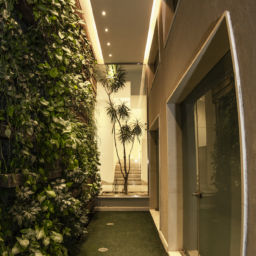
Sustainable Landscape has become a major issue of debate within decision-making circles for urban policies. And speaking of landscape architecture we go in two directions.
The first is to achieve the aesthetic view and protect the natural assets and picturesque scenery.
The second is the design that considers multiple dynamics that serve the ecosystem and human well-being. Given the centrality of the concept of “sustainability” in our time, it is not surprising to hear about the term “sustainable landscape”.
The definition of sustainable landscape is not clear yet, as academics, architects, and government officials use the term on the assumption that they are making a general definition of the concept by defining its relationship to a geographical context. In the context of defining “sustainability”.
According to Paul Selman, the concept of “sustainable landscape” carries these three dimensions: environment, economy, and society.
1- The Environmental Sustainability of Landscape
The environmental dimension in the sustainable landscape is related to the architecture’s ability to multiply its functions, services, and resilience. When we talk about its functions, we are talking about biodiversity and soil filters.
Landscape sustainability has also been associated with other natural environmental factors, notably the maintenance of soil moisture and nutrient status, the integrity of water quality and quantity in surface and underground hydrological systems, and the effect of vegetation on the equivalence of local climate and atmospheric carbon levels. According to the Millennium Assessment Report in 2005, the idea of ecosystem services has been popularized, which are:
- Provide Services such as food, wood and fiber.
- Regulating services in climate change, floods, Wastes, and water quality.
- Promote cultural services that provide recreational, aesthetic and spiritual values.
- Supportive services such as soil formation, photosynthesis, and nutrient cycling.
2- The Economic Sustainability of Landscape
The economic sustainability of the landscape is often expressed as the preservation of attractive landscapes to support tourism and recreation. Although this superficial definition omits many aspects, it remains acceptable when heard.
At the heart of economic landscape sustainability lies the concept of a “virtuous circle in which mainstream endogenous, spontaneous production spins out landscape benefits that in turn make the local area attractive for producers to maintain and embed supportive environmental practices. This synergy is fully expressed in terms of specialty foods and wood products that bring a premium based on distinctive local identity and in relation to the impact of urban green spaces on property values. However, many unexplored opportunities, both urban and rural, relate to drivers of landscape change, such as housing, energy and infrastructure.
3- The Social Sustainability of Landscape
Social sustainability in landscapes is often addressed in terms of participation and inclusiveness in decision-making and access. While these practices are necessary, they are not sufficient. Whereas the clarity of a landscape’s narrative is critical to its perceived value, while an understanding of its rules—whether codified or implied—is central to its portability and usability. Some places, for example, may be landscapes of security or fear for a group of residents or migrants.

The first is the incorporation of public preferences through relatively sophisticated methods of participatory design and landscape assessment. However, this often remains on a relatively superficial level and lacks a clearly articulated model of client-centered design where users may be from diverse cultural and social groups.
Second, landscapes provide a powerful environment for “social” learning. Especially where people are separated from everyday contact with land and rivers, rediscovering the pleasant environment through the middle of the landscape may facilitate re-engagement and appreciation of aesthetic values that include nature.
Third and finally, recognition is rapidly expanding in the landscape’s relationship to health, fitness, and well-being. Several studies have attempted to link plant space with mental and physical healing and wellness, but even in this limited context, the accuracy and complexity of the links make research design intractable.













